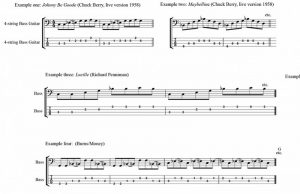Deep Thinking: Chuck Berry
Deep Thinking: Chuck Berry
Just as I had finished writing about the mathematical complexities of Meshuggah and Tessaract in the last edition, the news came through of Chuck Berry’s passing. I thought that, given the huge musical legacy he left, and all the bands he influenced (Stones, Beatles, Beach Boys and many more), it would be worth looking back at the roots of what became that rather vague term ‘rock’, which means something different to just about every rock musician I have ever spoken to!
Listening to rock and roll from the early to mid 1950s, you can hear the meeting of Afro–American rhythm and blues and some elements of country music. The problem I had transcribing some of these lines, however, was that many were recorded on an under–amplified double bass (despite in Chuck’s case, that bassist was the legendary Willie Dixon). In the songs of Little Richard and Jerry Lee Lewis, the bass was dominated by the piano left hand (despite Little Richard’s bassist using firstly a Gibson EB1 bass and then an early Fender Precision).
I have therefore transcribed the parts I could hear and added a few notes here and there that I have seen R and B bassists play live. Most rock and roll tunes of this era were in a 12 bar form, but not all, particularly Chuck’s songs.
Example one is probably Chuck’s most played song, Johnny B. Goode, one with which many cover bands will end an evening and it is mainly a 12 bar. Notice how the minor third, Eb, rises to the major third, E, a throwback to the stride piano playing of the 1930s and 1940s. The rest is a simple pentatonic series of notes. It is almost the same line used by Little Richard in Good Golly Miss Molly. Versions of both of these songs were taken from live performances in 1958 by which time both performers had achieved great success.
Example two is Chuck’s Maybelline. While the choruses are in 12 bar formats, the verses stay on the root chord, Bb, while the bass plays a root/fifth (Bb to F) two notes to the bar pattern. The chorus bassline is basically a pentatonic scale. Chuck was inventive in his song writing of the time so as to give himself a point of difference from other rock and roll stars. For example, Memphis Tennessee is in Eb, but the verses stay on Bb and only return to Eb for the choruses. Also, notice that he didn’t rely on open chords.
Example three is a Little Richard song that uses C mixolydian as a bassline structure and this groove doesn’t swing like Chuck’s two tunes above. This 1957 version of Lucille uses the bassline riff in conjunction with the piano and guitar, and the line starts as a major triad before using the high Bb (the seventh note of the scale) quavers that give the song a bluesy feel.
Example four is a line, or a part of one, that I was shown by a famous (in the UK, Zoot Money) rhythm and blues keyboard player so that I could double it with his left hand part. It features the root note rising to the minor third then major third movement in the first two bars, as in Johnny B. Goode, then rises to the seventh (Mixolydian) note F before descending through the thirds and back to the root note. The line is in a 12 bar form but I have only included four bars because you will soon get used to it. The third and fourth bars are trickier because the root notes and both thirds keep crossing the beat in groups of three quavers before returning to the root chord, G so a drum machine or metronome might be useful to keep you in time while you get familiar with the rhythm.
These are just a few simple examples of lines that are usually interchangeable between rock and roll songs, so you can mix them up if you wish. Chuck Berry’s name and his music will be around for a long time to come. To more or less paraphrase John Lennon, ‘if you want to call rock and roll something else, call it Chuck Berry’.
Dr. Rob Burns is an Associate Professor in Music at the University of Otago in Dunedin. As a former professional studio bassist in the UK, he performed and recorded with David Gilmour, Pete Townsend, Jerry Donahue, Isaac Hayes, Sam and Dave, James Burton, Ian Paice and Jon Lord, Eric Burdon and members of Abba. He played on the soundtracks on many UK television shows, such as Red Dwarf, Mr. Bean, Blackadder, Not the Nine O’Clock News, and Alas Smith and Jones. Rob is currently a member of Dunedin bands Subject2change and The Verlaines.

